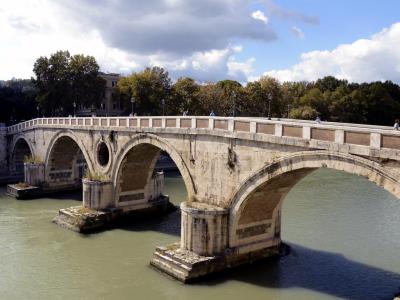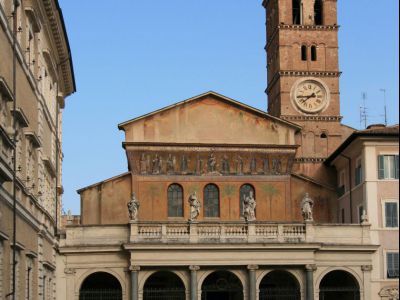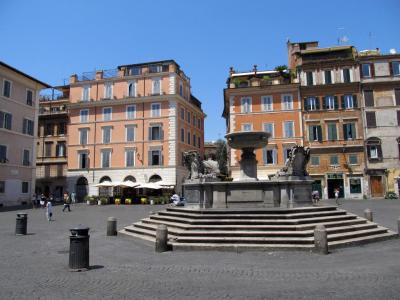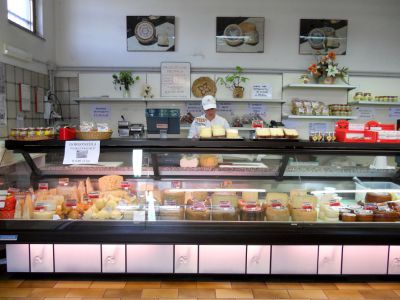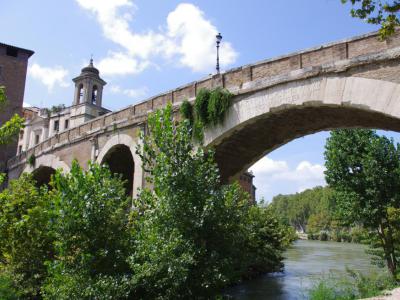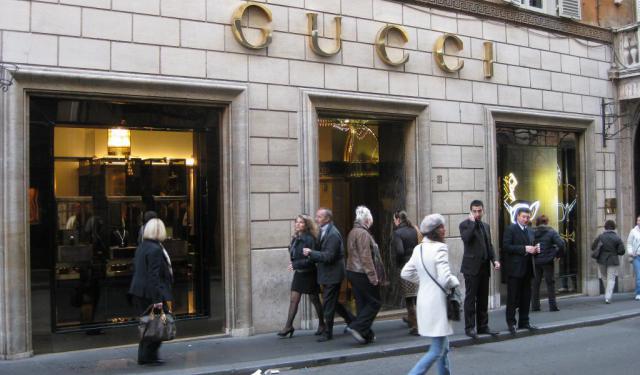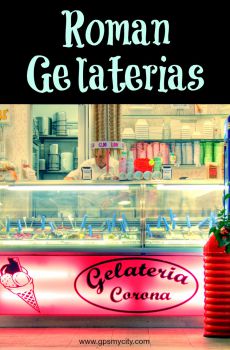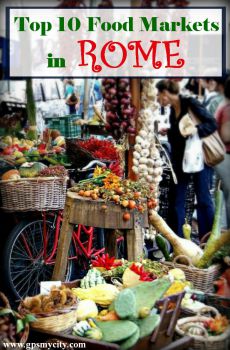
Trastevere Walking Tour (Self Guided), Rome
Heading down from the Vatican along the River Tiber, one is bound to find yet another city hidden within the city – Trastevere. This name translates literally to "across the Tiber". Indeed, crossing the picturesque Ponte Sisto (Sisto Bridge) to the west bank, you will find yourself in a charming neighborhood with a distinct character that sets it apart from any other part of Rome.
The unique identity of this enclave derived from the locals who generally greeted creeping commercialization and ongoing attempts at gentrification with a wonderfully Roman disdain. A strong sense of civic pride resides among the Medieval maze of piazzas (squares) and narrow cobbled vicoli (alleyways) here.
In the heart of the neighborhood lies the beautiful Piazza di Santa Maria dominated by the basilica of the same name, one of the oldest churches in Rome. Joining in the fun, becoming a part of Trastevere’s great bustling backdrop is easy to do, whether you’re simply sitting on the steps of the lively Piazza Trilussa or ordering coffee at the counter of one of the area’s many bars.
Museo di Roma (Museum of Rome), located in the former monastery of Sant'Egidio, is dedicated to preserving and showcasing the history and culture of Rome.
Antica Caciara is a renowned delicatessen in Trastevere that specializes in traditional Roman cured meats and cheeses. It's a popular spot for food enthusiasts to sample and purchase high-quality local products, such as prosciutto, salami, and various types of pecorino cheese.
The charming Isola Tiberina (Tiber Island), in the middle of the river, is accessible via the Ponte Fabricio, the oldest Roman bridge still in use – remarkably since 62 BC!!!
Trastevere, the epitome of la dolce vita (good life), offers a glimpse into the soul of Rome. Here, the spirit of Renaissance lingers in the air and the ancient traditions blend seamlessly with contemporary delights, leaving visitors captivated and longing for more.
To indulge your senses in the sensory symphony of Trastevere, we invite you to embark on this self-guided odyssey through an oasis of refined decadence, where the cacophony of laughter, clinking glasses, and the melodic notes of street musicians intertwine to create an atmosphere of pure elegance and joy of living.
The unique identity of this enclave derived from the locals who generally greeted creeping commercialization and ongoing attempts at gentrification with a wonderfully Roman disdain. A strong sense of civic pride resides among the Medieval maze of piazzas (squares) and narrow cobbled vicoli (alleyways) here.
In the heart of the neighborhood lies the beautiful Piazza di Santa Maria dominated by the basilica of the same name, one of the oldest churches in Rome. Joining in the fun, becoming a part of Trastevere’s great bustling backdrop is easy to do, whether you’re simply sitting on the steps of the lively Piazza Trilussa or ordering coffee at the counter of one of the area’s many bars.
Museo di Roma (Museum of Rome), located in the former monastery of Sant'Egidio, is dedicated to preserving and showcasing the history and culture of Rome.
Antica Caciara is a renowned delicatessen in Trastevere that specializes in traditional Roman cured meats and cheeses. It's a popular spot for food enthusiasts to sample and purchase high-quality local products, such as prosciutto, salami, and various types of pecorino cheese.
The charming Isola Tiberina (Tiber Island), in the middle of the river, is accessible via the Ponte Fabricio, the oldest Roman bridge still in use – remarkably since 62 BC!!!
Trastevere, the epitome of la dolce vita (good life), offers a glimpse into the soul of Rome. Here, the spirit of Renaissance lingers in the air and the ancient traditions blend seamlessly with contemporary delights, leaving visitors captivated and longing for more.
To indulge your senses in the sensory symphony of Trastevere, we invite you to embark on this self-guided odyssey through an oasis of refined decadence, where the cacophony of laughter, clinking glasses, and the melodic notes of street musicians intertwine to create an atmosphere of pure elegance and joy of living.
How it works: Download the app "GPSmyCity: Walks in 1K+ Cities" from Apple App Store or Google Play Store to your mobile phone or tablet. The app turns your mobile device into a personal tour guide and its built-in GPS navigation functions guide you from one tour stop to next. The app works offline, so no data plan is needed when traveling abroad.
Trastevere Walking Tour Map
Guide Name: Trastevere Walking Tour
Guide Location: Italy » Rome (See other walking tours in Rome)
Guide Type: Self-guided Walking Tour (Sightseeing)
# of Attractions: 11
Tour Duration: 2 Hour(s)
Travel Distance: 2.9 Km or 1.8 Miles
Author: audrey
Sight(s) Featured in This Guide:
Guide Location: Italy » Rome (See other walking tours in Rome)
Guide Type: Self-guided Walking Tour (Sightseeing)
# of Attractions: 11
Tour Duration: 2 Hour(s)
Travel Distance: 2.9 Km or 1.8 Miles
Author: audrey
Sight(s) Featured in This Guide:
- Ponte Sisto (Sisto Bridge)
- Piazza Trilussa (Trilussa Square)
- Museo di Roma in Trastevere (Museum of Rome in Trastevere)
- Basilica di Santa Maria in Trastevere (Basilica of Our Lady in Trastevere)
- Piazza di Santa Maria in Trastevere (Square of Santa Maria in Trastevere)
- Chiesa di San Pietro in Montorio (Church of St. Peter on the Golden Mountain)
- Piazza San Cosimato (San Cosimato Square)
- Antica Caciara
- Basilica di Santa Cecilia in Trastevere (Basilica of St. Cecilia in Trastevere)
- Isola Tiberina (Tiber Island)
- Ponte Fabricio (Fabrician Bridge)
1) Ponte Sisto (Sisto Bridge)
Ponte Sisto, located in Rome's historic center, is a picturesque bridge that spans the Tiber River. The construction of the current bridge took place between 1473 and 1479, commissioned by Pope Sixtus IV, who the bridge is named after. The architect Baccio Pontelli was responsible for the design, utilizing the foundations of the previous Roman bridge, known as Pons Aurelius or Pons Antoninus, which had been destroyed during the early Middle Ages.
Today, Ponte Sisto is solely dedicated to pedestrian traffic, creating a serene and enjoyable crossing experience. One of the distinctive architectural features of the bridge is the "oculus" or eye that lightens the masonry of its central spandrel. This addition was strategically erected to alleviate the pressure exerted by the river during times of flooding, ensuring the bridge's stability and longevity.
On the left side of the bridge's entrance, you can find replicas of two marble slabs that originally adorned the bridge. These slabs, unfortunately removed in the 1990s due to ongoing vandalism, displayed an elegant Latin inscription composed by Renaissance humanist Bartolomeo Platina. The inscription honored Pope Sixtus IV and commemorated the construction of the bridge.
Ponte Sisto serves as a vital link between the lively Campo de' Fiori area and Piazza Trilussa in Trastevere. It offers a picturesque setting for leisurely strolls, scenic views of the Tiber River, and a charming ambiance that attracts both locals and tourists. The bridge has become an iconic landmark in Rome, serving as a gathering place for people to enjoy an evening aperitivo or simply soak in the beauty of the Eternal City.
Today, Ponte Sisto is solely dedicated to pedestrian traffic, creating a serene and enjoyable crossing experience. One of the distinctive architectural features of the bridge is the "oculus" or eye that lightens the masonry of its central spandrel. This addition was strategically erected to alleviate the pressure exerted by the river during times of flooding, ensuring the bridge's stability and longevity.
On the left side of the bridge's entrance, you can find replicas of two marble slabs that originally adorned the bridge. These slabs, unfortunately removed in the 1990s due to ongoing vandalism, displayed an elegant Latin inscription composed by Renaissance humanist Bartolomeo Platina. The inscription honored Pope Sixtus IV and commemorated the construction of the bridge.
Ponte Sisto serves as a vital link between the lively Campo de' Fiori area and Piazza Trilussa in Trastevere. It offers a picturesque setting for leisurely strolls, scenic views of the Tiber River, and a charming ambiance that attracts both locals and tourists. The bridge has become an iconic landmark in Rome, serving as a gathering place for people to enjoy an evening aperitivo or simply soak in the beauty of the Eternal City.
2) Piazza Trilussa (Trilussa Square)
Piazza Trilussa in Rome is a vibrant square located in the heart of the Trastevere district, known for its lively atmosphere and popular among both young Romans and tourists. Situated in front of the Ponte Sisto this charming square is dedicated to Carlo Alberto Salustri, the renowned Roman satirical poet better known as Trilussa.
At the center of Piazza Trilussa stands the beautiful fountain of Acqua Paola, designed by architects Van Santen, known as Vasanzio, and Giovanni Fontana. This fountain was commissioned by Pope Paul V Borghese in 1613 to provide water to the districts of Trastevere, Borgo, Regola, and Ponte. The fountain features a monumental arch with a central niche flanked by two Ionic columns. An elevated attic displays the Borghese family coat of arms, featuring an eagle and a dragon, along with a celebratory inscription dedicated to the pontiff for bringing water to the left bank of the Tiber.
In 1870, due to the construction of the Tiber's embankments following a devastating flood, the fountain was dismantled. Unfortunately, almost half of the pieces broke or were scattered among different municipal warehouses. In 1898, when the fountain was reconstructed in Piazza Trilussa, architect Vescovali was only able to use what remained of it. Nevertheless, the result was remarkable.
In addition to the fountain, the square is adorned with a monument celebrating the great Roman poet Trilussa. Born in Rome in 1871 and passing away in 1950, Trilussa gained fame for his ironic poems that satirized corrupt politicians, fanaticism, and the intrigues of the powerful. The bronze statue of the poet, depicting him reciting his poems, was created by sculptor Lorenzo Ferri and inaugurated on December 21, 1954.
At the center of Piazza Trilussa stands the beautiful fountain of Acqua Paola, designed by architects Van Santen, known as Vasanzio, and Giovanni Fontana. This fountain was commissioned by Pope Paul V Borghese in 1613 to provide water to the districts of Trastevere, Borgo, Regola, and Ponte. The fountain features a monumental arch with a central niche flanked by two Ionic columns. An elevated attic displays the Borghese family coat of arms, featuring an eagle and a dragon, along with a celebratory inscription dedicated to the pontiff for bringing water to the left bank of the Tiber.
In 1870, due to the construction of the Tiber's embankments following a devastating flood, the fountain was dismantled. Unfortunately, almost half of the pieces broke or were scattered among different municipal warehouses. In 1898, when the fountain was reconstructed in Piazza Trilussa, architect Vescovali was only able to use what remained of it. Nevertheless, the result was remarkable.
In addition to the fountain, the square is adorned with a monument celebrating the great Roman poet Trilussa. Born in Rome in 1871 and passing away in 1950, Trilussa gained fame for his ironic poems that satirized corrupt politicians, fanaticism, and the intrigues of the powerful. The bronze statue of the poet, depicting him reciting his poems, was created by sculptor Lorenzo Ferri and inaugurated on December 21, 1954.
3) Museo di Roma in Trastevere (Museum of Rome in Trastevere)
The Museum of Rome in Trastevere is located in the restored Carmelite convent of Sant'Egidio in Rome. Originally established in 1977 as the Museo del Folklore e dei Poeti Romaneschi (Museum of Folklore and Roman Dialect Poets), it was later renamed and reopened in 2000 as the Museo di Roma in Trastevere. The museum is part of the Museo di Roma and offers a unique perspective on the recent culture of Rome.
The museum features a permanent collection that showcases Roman art from the 18th to the first half of the 20th century. Among the notable works are pieces by Ettore Roesler Franz, a renowned chronicler of Rome. His watercolor series, "Vanishing Rome," provides a captivating record of the changing cityscape in the late 1800s. These artworks offer visitors a glimpse into Rome's rich artistic heritage and the evolving urban landscape over time.
In addition to its permanent collection, the Museum of Rome in Trastevere hosts temporary exhibitions throughout the year. These exhibits cover a wide range of artistic mediums, including photography, reportage, and video. Notably, the museum is known for hosting the annual World Press Photo exhibition, which showcases powerful and impactful photojournalism from around the world.
One unique feature of the museum is the display of the "Roman Scenes," life-size models that were previously exhibited in the Museo di Roma at Palazzo Braschi. Due to limited space and the desire to highlight popular Roman culture, these models were relocated to the Trastevere location. This decision allows visitors to experience the vibrant and lively atmosphere of Rome's popular culture, as it remains strong in the Trastevere neighborhood.
The museum features a permanent collection that showcases Roman art from the 18th to the first half of the 20th century. Among the notable works are pieces by Ettore Roesler Franz, a renowned chronicler of Rome. His watercolor series, "Vanishing Rome," provides a captivating record of the changing cityscape in the late 1800s. These artworks offer visitors a glimpse into Rome's rich artistic heritage and the evolving urban landscape over time.
In addition to its permanent collection, the Museum of Rome in Trastevere hosts temporary exhibitions throughout the year. These exhibits cover a wide range of artistic mediums, including photography, reportage, and video. Notably, the museum is known for hosting the annual World Press Photo exhibition, which showcases powerful and impactful photojournalism from around the world.
One unique feature of the museum is the display of the "Roman Scenes," life-size models that were previously exhibited in the Museo di Roma at Palazzo Braschi. Due to limited space and the desire to highlight popular Roman culture, these models were relocated to the Trastevere location. This decision allows visitors to experience the vibrant and lively atmosphere of Rome's popular culture, as it remains strong in the Trastevere neighborhood.
4) Basilica di Santa Maria in Trastevere (Basilica of Our Lady in Trastevere)
Situated in the historic Trastevere district, Piazza Santa Maria in Trastevere derives its name from the nearby church, which underwent a splendid restoration of its facade mosaics in 2018. This church, considered Rome's first official Christian place of worship, was established by Pope Callixtus I in the 3rd century, during a time when Christianity remained a minority belief. Its location is said to be where an oil fountain miraculously emerged on the day of Christ's birth.
Today, the church predominantly reflects a 12th-century structure renowned for its magnificent mosaics. Particularly noteworthy is the apse mosaic depicting the Coronation of the Virgin, alongside the six mosaics by Pietro Cavallini below, which portray the life of the Virgin with remarkable realism. The nave showcases twenty-two granite columns sourced from the remnants of ancient Roman buildings. Despite some additions in the 18th-century Baroque style, Santa Maria has preserved its medieval charm.
Beneath the grand altar on the right, an inscription reading "FONS OLEI" designates the spot where the oil is believed to have gushed forth.
Why You Should Visit:
One of the oldest (if not the oldest) churches in Rome; extremely ornate and well worth a visit when visiting Trastevere.
During the evening, the church's facade sparkles with the illuminated brilliance of its mosaics.
Tip:
Similar to other churches, it is customary to have your shoulders and knees covered, regardless of the outside temperature.
A good idea would be to plan on spending a little extra time in the area to grab lunch, dinner or gelato.
Today, the church predominantly reflects a 12th-century structure renowned for its magnificent mosaics. Particularly noteworthy is the apse mosaic depicting the Coronation of the Virgin, alongside the six mosaics by Pietro Cavallini below, which portray the life of the Virgin with remarkable realism. The nave showcases twenty-two granite columns sourced from the remnants of ancient Roman buildings. Despite some additions in the 18th-century Baroque style, Santa Maria has preserved its medieval charm.
Beneath the grand altar on the right, an inscription reading "FONS OLEI" designates the spot where the oil is believed to have gushed forth.
Why You Should Visit:
One of the oldest (if not the oldest) churches in Rome; extremely ornate and well worth a visit when visiting Trastevere.
During the evening, the church's facade sparkles with the illuminated brilliance of its mosaics.
Tip:
Similar to other churches, it is customary to have your shoulders and knees covered, regardless of the outside temperature.
A good idea would be to plan on spending a little extra time in the area to grab lunch, dinner or gelato.
5) Piazza di Santa Maria in Trastevere (Square of Santa Maria in Trastevere)
Piazza di Santa Maria in Trastevere is a captivating square dominated by the magnificent Basilica of Santa Maria in Trastevere. The square derives its name from this basilica and also features a fountain considered to be the oldest in Rome, as it stands on the same spot where a fountain existed during the time of Emperor Augustus.
Adjacent to the basilica stands the Palazzo San Callisto, a seventeenth-century building owned by the Holy See. At the center of the square, a beautiful fountain graces the surroundings. This fountain is one of the oldest among Rome's monumental fountains and can be traced back to the plan of Pietro del Massaio in 1471. The fountain's current design consists of a polygonal basin with two overlapping basins, although it was originally larger before being reduced to its present form.
The history of this splendid Trastevere fountain is quite eventful and can be explored through the four inscriptions found in the lower basin. Significant restoration efforts were undertaken in 1604 by Pope Clement VIII Aldobrandini (1592-1605) and later by Pope Alexander VII Chigi (1655-1667). In 1659, Alexander VII commissioned Gian Lorenzo Bernini to increase the water flow, which was previously scarce in the neighborhood. Bernini incorporated four double shells facing outward into the basin, adding his artistic touch to the fountain.
In 1692, during the pontificate of Pope Innocent XII Pignatelli (1691-1700), Carlo Fontana replaced Bernini's shells with larger ones facing inward, giving the fountain its present appearance.
Adjacent to the basilica stands the Palazzo San Callisto, a seventeenth-century building owned by the Holy See. At the center of the square, a beautiful fountain graces the surroundings. This fountain is one of the oldest among Rome's monumental fountains and can be traced back to the plan of Pietro del Massaio in 1471. The fountain's current design consists of a polygonal basin with two overlapping basins, although it was originally larger before being reduced to its present form.
The history of this splendid Trastevere fountain is quite eventful and can be explored through the four inscriptions found in the lower basin. Significant restoration efforts were undertaken in 1604 by Pope Clement VIII Aldobrandini (1592-1605) and later by Pope Alexander VII Chigi (1655-1667). In 1659, Alexander VII commissioned Gian Lorenzo Bernini to increase the water flow, which was previously scarce in the neighborhood. Bernini incorporated four double shells facing outward into the basin, adding his artistic touch to the fountain.
In 1692, during the pontificate of Pope Innocent XII Pignatelli (1691-1700), Carlo Fontana replaced Bernini's shells with larger ones facing inward, giving the fountain its present appearance.
6) Chiesa di San Pietro in Montorio (Church of St. Peter on the Golden Mountain)
San Pietro in Montorio, also known as Saint Peter on the Golden Mountain stands on the Janiculum hill, where an earlier 9th-century church dedicated to Saint Peter once existed. San Pietro in Montorio is considered a sacred place, as it marks the supposed site of Saint Peter's crucifixion.
While the exterior of the Church of San Pietro in Montorio may not be particularly appealing, its interior is a true treasure trove of artwork. The church houses an impressive collection that is difficult to find elsewhere, especially free of charge. One of the main attractions within the church is the Tempietto, a structure located in the inner cloister. This tempietto is built on the exact spot where Saint Peter is believed to have been crucified. The historical evidence supporting Saint Peter's presence and martyrdom in Rome is significant, adding to the sacredness of this site.
The interior of the church is adorned with exquisite artworks created by renowned artists of the 16th and 17th centuries. Until 1797, Raphael's final masterpiece, the Transfiguration, graced the high altar of the church. However, during the Napoleonic period, the altarpiece was taken by the French as part of a treaty and is now housed in the Vatican Pinacoteca. Currently, a copy by Cammuccini of Guido Reni's Crucifixion of Saint Peter is displayed on the altar.
Among the other notable artworks in the church, the first chapel on the right houses Sebastiano del Piombo's Flagellation and Transfiguration, which incorporate figure drawings supplied by Michelangelo. The second chapel features a fresco by Niccolò Circignani from 1554, as well as Renaissance frescoes from the school of Pinturicchio, including an allegorical sibyl and virtue attributed to Baldassarre Peruzzi.
In the fourth chapel, visitors can admire a stunning ceiling fresco created by Giorgio Vasari. Furthermore, the fifth chapel's ceiling depicts another remarkable fresco, the Conversion of Saint Paul, also painted by Vasari.
While the exterior of the Church of San Pietro in Montorio may not be particularly appealing, its interior is a true treasure trove of artwork. The church houses an impressive collection that is difficult to find elsewhere, especially free of charge. One of the main attractions within the church is the Tempietto, a structure located in the inner cloister. This tempietto is built on the exact spot where Saint Peter is believed to have been crucified. The historical evidence supporting Saint Peter's presence and martyrdom in Rome is significant, adding to the sacredness of this site.
The interior of the church is adorned with exquisite artworks created by renowned artists of the 16th and 17th centuries. Until 1797, Raphael's final masterpiece, the Transfiguration, graced the high altar of the church. However, during the Napoleonic period, the altarpiece was taken by the French as part of a treaty and is now housed in the Vatican Pinacoteca. Currently, a copy by Cammuccini of Guido Reni's Crucifixion of Saint Peter is displayed on the altar.
Among the other notable artworks in the church, the first chapel on the right houses Sebastiano del Piombo's Flagellation and Transfiguration, which incorporate figure drawings supplied by Michelangelo. The second chapel features a fresco by Niccolò Circignani from 1554, as well as Renaissance frescoes from the school of Pinturicchio, including an allegorical sibyl and virtue attributed to Baldassarre Peruzzi.
In the fourth chapel, visitors can admire a stunning ceiling fresco created by Giorgio Vasari. Furthermore, the fifth chapel's ceiling depicts another remarkable fresco, the Conversion of Saint Paul, also painted by Vasari.
7) Piazza San Cosimato (San Cosimato Square)
Located near the bustling main square of Rome's Trastevere district, Piazza Santa Maria in Trastevere, you'll discover the charming Piazza di San Cosimato. This square is home to a vibrant open-air local food market that springs to life six mornings a week, offering a delightful sensory experience for both locals and visitors alike.
With a history dating back to the early 20th century, the Piazza di San Cosimato market has long been a beloved institution in the neighborhood. Although smaller in scale compared to some of the larger markets in the city, it boasts a loyal following of patrons who appreciate its authenticity and community atmosphere. Many of the vendor families have been part of the market since its inception, passing down their stalls and prime locations from generation to generation.
As you stroll through the market, you'll be greeted by a colorful array of stalls offering an abundance of fresh, locally sourced produce. From vibrant fruits and vegetables to fragrant herbs and spices, the market showcases the best of Italy's culinary offerings. For seafood lovers, there are stalls brimming with fresh fish, while meat enthusiasts can find a selection of quality cuts. Cheese connoisseurs will be delighted to discover locally produced cheeses, and those with a taste for charcuterie will find a variety of cured meats to satisfy their palates.
While the focus of the Piazza di San Cosimato market is undoubtedly on gastronomic delights, it also offers a unique twist with the presence of a used book seller. This literary addition adds an intellectual flair to the market, inviting visitors to peruse the shelves and discover hidden literary gems amidst the lively ambiance.
With a history dating back to the early 20th century, the Piazza di San Cosimato market has long been a beloved institution in the neighborhood. Although smaller in scale compared to some of the larger markets in the city, it boasts a loyal following of patrons who appreciate its authenticity and community atmosphere. Many of the vendor families have been part of the market since its inception, passing down their stalls and prime locations from generation to generation.
As you stroll through the market, you'll be greeted by a colorful array of stalls offering an abundance of fresh, locally sourced produce. From vibrant fruits and vegetables to fragrant herbs and spices, the market showcases the best of Italy's culinary offerings. For seafood lovers, there are stalls brimming with fresh fish, while meat enthusiasts can find a selection of quality cuts. Cheese connoisseurs will be delighted to discover locally produced cheeses, and those with a taste for charcuterie will find a variety of cured meats to satisfy their palates.
While the focus of the Piazza di San Cosimato market is undoubtedly on gastronomic delights, it also offers a unique twist with the presence of a used book seller. This literary addition adds an intellectual flair to the market, inviting visitors to peruse the shelves and discover hidden literary gems amidst the lively ambiance.
8) Antica Caciara
In Rome, there are numerous places where tourists can discover exceptional cheese, and many of them are conveniently located near the city center. In the Trastevere neighborhood, locals flock to this deli to indulge in some of the freshest ricotta available. Stepping inside, you'll be greeted by generous portions of ham, salami, Sicilian anchovies, porcini mushrooms, luscious Sicilian olives, and creamy burrata cheese from Puglia. The deli also offers Parmigiano-Reggiano and local wines, all served with friendly and polite joviality.
If you wish to bring some Italian delicacies back home, the savory delights can be vacuum-sealed, although it's worth noting that not all products can be imported into other countries.
If you wish to bring some Italian delicacies back home, the savory delights can be vacuum-sealed, although it's worth noting that not all products can be imported into other countries.
9) Basilica di Santa Cecilia in Trastevere (Basilica of St. Cecilia in Trastevere)
This basilica is a tribute to Saint Cecilia, a noblewoman and the revered patron saint of musicians. During the early days of Christianity in ancient Rome, she suffered a prolonged and extraordinary death, believed to have been orchestrated by Emperor Diocletian around AD 300. In an attempt to quietly eliminate aristocrats, she was first subjected to suffocation in the baths of her own house, but this method proved unsuccessful. Subsequently, she faced the executioner, who struck her three times with a sword, yet astonishingly, the young girl did not succumb. She bravely endured for several days, using her remaining time to convert others to Christianity, until she eventually passed away.
In 1595, Saint Cecilia's body was exhumed and appeared remarkably well-preserved, as if she were still alive. Witnessing this poignant sight, the sculptor Stefano Maderno created a sculpture beneath the main altar that faithfully captured her appearance.
If you plan to visit, it is advisable to arrive in the morning and explore the secluded convent, where you can witness the remnants of Pietro Cavallini's "Last Judgment". Painted in 1293, this remarkable fresco is the sole surviving major artwork attributed to Cavallini, a contemporary of the renowned artist Giotto.
To access the frescoes, simply ring the bell of the convent located to the left of the church entrance between 10am and 12pm on weekdays.
In 1595, Saint Cecilia's body was exhumed and appeared remarkably well-preserved, as if she were still alive. Witnessing this poignant sight, the sculptor Stefano Maderno created a sculpture beneath the main altar that faithfully captured her appearance.
If you plan to visit, it is advisable to arrive in the morning and explore the secluded convent, where you can witness the remnants of Pietro Cavallini's "Last Judgment". Painted in 1293, this remarkable fresco is the sole surviving major artwork attributed to Cavallini, a contemporary of the renowned artist Giotto.
To access the frescoes, simply ring the bell of the convent located to the left of the church entrance between 10am and 12pm on weekdays.
10) Isola Tiberina (Tiber Island)
Tiber Island, known as Isola Tiberina in Italian, holds a unique place as the only river island within the part of the Tiber River that flows through Rome. Situated in the southern bend of the river, Tiber Island has a distinct boat-shaped appearance, measuring approximately 270 meters (890 feet) in length and 67 meters (220 feet) in width. It has been connected to both sides of the river by bridges since ancient times.
Throughout history, Tiber Island has been associated with medicine and healing due to its connection with the ancient temple of Asclepius and its later use as a hospital. The Fatebenefratelli Hospital, established in the 16th century, and the church of San Bartolomeo all'Isola, dating back to the 10th century, are prominent features on the island. These institutions further reinforce its connection to healthcare and wellness.
The island's original name, Insula Inter-Duos-Pontes, translates to "the island between the two bridges," highlighting its location between the Ponte Fabricio and the Ponte Cestio. The Ponte Fabricio, which connects the island to the northeast and the Field of Mars, is the only remaining original bridge in Rome. On the other hand, the Ponte Cestio, although some parts are original, links the island to the southern bank in the neighborhood of Trastevere.
Legend has it that Tiber Island originated from the body of the despised tyrant Tarquinius Superbus, who was overthrown in 510 BC. According to the story, after his fall, Romans threw his body into the Tiber, and it settled at the river's bottom. Over time, dirt and silt accumulated around the body, eventually forming Tiber Island. Another version of the legend suggests that the people gathered the wheat and grain associated with the tyrant and cast it into the Tiber, which eventually served as the foundation for the island.
In ancient times, prior to the spread of Christianity in Rome, Tiber Island carried a negative reputation, and people tended to avoid it. It was believed to be a place of punishment reserved for the worst criminals and the contagiously ill. However, with the construction of a temple on the island, its perception changed, and it became associated with healing and divine intervention.
Today, Tiber Island stands as a historic and picturesque site, offering a tranquil escape from the bustling city. Its connections to Roman mythology, ancient medicine, and architectural heritage make it a unique destination for locals and tourists alike.
Throughout history, Tiber Island has been associated with medicine and healing due to its connection with the ancient temple of Asclepius and its later use as a hospital. The Fatebenefratelli Hospital, established in the 16th century, and the church of San Bartolomeo all'Isola, dating back to the 10th century, are prominent features on the island. These institutions further reinforce its connection to healthcare and wellness.
The island's original name, Insula Inter-Duos-Pontes, translates to "the island between the two bridges," highlighting its location between the Ponte Fabricio and the Ponte Cestio. The Ponte Fabricio, which connects the island to the northeast and the Field of Mars, is the only remaining original bridge in Rome. On the other hand, the Ponte Cestio, although some parts are original, links the island to the southern bank in the neighborhood of Trastevere.
Legend has it that Tiber Island originated from the body of the despised tyrant Tarquinius Superbus, who was overthrown in 510 BC. According to the story, after his fall, Romans threw his body into the Tiber, and it settled at the river's bottom. Over time, dirt and silt accumulated around the body, eventually forming Tiber Island. Another version of the legend suggests that the people gathered the wheat and grain associated with the tyrant and cast it into the Tiber, which eventually served as the foundation for the island.
In ancient times, prior to the spread of Christianity in Rome, Tiber Island carried a negative reputation, and people tended to avoid it. It was believed to be a place of punishment reserved for the worst criminals and the contagiously ill. However, with the construction of a temple on the island, its perception changed, and it became associated with healing and divine intervention.
Today, Tiber Island stands as a historic and picturesque site, offering a tranquil escape from the bustling city. Its connections to Roman mythology, ancient medicine, and architectural heritage make it a unique destination for locals and tourists alike.
11) Ponte Fabricio (Fabrician Bridge)
The Ponte Fabricio or the Ponte dei Quattro Capi, stands as the oldest Roman bridge in Rome, that still exists in its original form. Its construction took place in 62 BC, and it spans across half of the Tiber River, connecting the Campus Martius on the eastern side to Tiber Island in the middle. The Pons Cestius is located west of the island.
The name "Quattro Capi" refers to the two marble pillars of the two-faced Janus herms found on the bridge's parapet. These pillars were relocated from the nearby Church of St Gregory (Monte Savello) during the 14th century. According to Dio Cassius, the bridge was commissioned by Lucius Fabricius, a member of the gens Fabricia and the curator of the roads in Rome. It was constructed in 62 BC, the year following Cicero's consulship, as a replacement for an earlier wooden bridge that had been destroyed by fire. Remarkably, the Pons Fabricius has remained completely intact from its Roman antiquity and has been in continuous use ever since.
The Pons Fabricius measures 62 meters in length and is 5.5 meters wide. It consists of two wide arches spanning 80 feet, supported by a central pillar positioned in the middle of the river. Notably, the arches on this bridge deviate from the traditional semi-circular design seen in previous Roman bridges. This departure is likely due to the fact that the semi-circle would have been submerged below the waterline. The core of the bridge is constructed from tuff, a type of volcanic rock, while the outer facing is composed of bricks and travertine.
One interesting feature of the Pons Fabricius is a relief located 20 feet above the pier. During times of flooding, this relief served as an additional waterway, allowing excess water to flow through. This innovative design element helped alleviate pressure on the bridge during periods of high water levels.
The Pons Fabricius stands as a remarkable testament to ancient Roman engineering and craftsmanship. As the oldest surviving bridge in Rome, it serves as a physical link to the city's rich history and provides a glimpse into the architectural achievements of the Roman Empire. Today, it continues to be used by pedestrians, maintaining its function as a vital crossing point over the Tiber River.
The name "Quattro Capi" refers to the two marble pillars of the two-faced Janus herms found on the bridge's parapet. These pillars were relocated from the nearby Church of St Gregory (Monte Savello) during the 14th century. According to Dio Cassius, the bridge was commissioned by Lucius Fabricius, a member of the gens Fabricia and the curator of the roads in Rome. It was constructed in 62 BC, the year following Cicero's consulship, as a replacement for an earlier wooden bridge that had been destroyed by fire. Remarkably, the Pons Fabricius has remained completely intact from its Roman antiquity and has been in continuous use ever since.
The Pons Fabricius measures 62 meters in length and is 5.5 meters wide. It consists of two wide arches spanning 80 feet, supported by a central pillar positioned in the middle of the river. Notably, the arches on this bridge deviate from the traditional semi-circular design seen in previous Roman bridges. This departure is likely due to the fact that the semi-circle would have been submerged below the waterline. The core of the bridge is constructed from tuff, a type of volcanic rock, while the outer facing is composed of bricks and travertine.
One interesting feature of the Pons Fabricius is a relief located 20 feet above the pier. During times of flooding, this relief served as an additional waterway, allowing excess water to flow through. This innovative design element helped alleviate pressure on the bridge during periods of high water levels.
The Pons Fabricius stands as a remarkable testament to ancient Roman engineering and craftsmanship. As the oldest surviving bridge in Rome, it serves as a physical link to the city's rich history and provides a glimpse into the architectural achievements of the Roman Empire. Today, it continues to be used by pedestrians, maintaining its function as a vital crossing point over the Tiber River.
Walking Tours in Rome, Italy
Create Your Own Walk in Rome
Creating your own self-guided walk in Rome is easy and fun. Choose the city attractions that you want to see and a walk route map will be created just for you. You can even set your hotel as the start point of the walk.
Spanish Steps to Trevi Fountain
An established tourist mecca, today's Rome is hardly imaginable without two of its much loved attractions – the Spanish Steps and the Trevi Fountain. Magnets for tourists as they are, these two sights are connected to a number of other, not less worthy of attention locations, such as the Fountain of the Longboat or Piazza Colonna and its centerpiece, the Column of Marcus Aurelius, to... view more
Tour Duration: 1 Hour(s)
Travel Distance: 2.0 Km or 1.2 Miles
Tour Duration: 1 Hour(s)
Travel Distance: 2.0 Km or 1.2 Miles
Rome Introduction Walking Tour II
Rome, the Eternal City, carries a legacy shaped by centuries of resilience, transformation, and cultural flourishing. The fall of the Roman Empire in 476 AD marked the end of an era, plunging Western Europe into the dark Middle Ages. Yet, even amid the disarray, Rome endured as a beacon of unity, largely due to its status as the center of Catholicism. The papacy wielded spiritual influence,... view more
Tour Duration: 2 Hour(s)
Travel Distance: 3.4 Km or 2.1 Miles
Tour Duration: 2 Hour(s)
Travel Distance: 3.4 Km or 2.1 Miles
Rome Introduction Walking Tour I
Often referred to as the Eternal City, Rome holds a unique place in the story of Western civilization. Its influence shaped European culture through language, governance, and monumental architecture.
The name “Rome” originates from Romulus, the mythical founder of the city, who, according to legend, was the son of the war god Mars and Rhea Silvia, the priestess of goddess Vesta. Both,... view more
Tour Duration: 2 Hour(s)
Travel Distance: 3.3 Km or 2.1 Miles
The name “Rome” originates from Romulus, the mythical founder of the city, who, according to legend, was the son of the war god Mars and Rhea Silvia, the priestess of goddess Vesta. Both,... view more
Tour Duration: 2 Hour(s)
Travel Distance: 3.3 Km or 2.1 Miles
Vatican Walking Tour
Consisting of a walled enclave within the city of Rome, the Vatican is the world’s smallest sovereign state, as well as a symbol (and headquarters) of the Roman Catholic faith. Although only 44 hectares in surface, one is amazed by the vastness of this place and the sheer size of everything. When gazing around in all directions, you realize how much can be achieved by people working in faith for... view more
Tour Duration: 2 Hour(s)
Travel Distance: 3.4 Km or 2.1 Miles
Tour Duration: 2 Hour(s)
Travel Distance: 3.4 Km or 2.1 Miles
Rome Shopping Streets Walking Tour
Loved by tourists for its busy fashionable streets and significant baroque icons, the so-called ‘Tridente’ is one of the Eternal City's most lusted-after areas, formed by Via dei Condotti, Via Borgognona, Via Frattina and the adjacent Via del Corso. It is perhaps the most high-end destination for Roman shopping, with a concentration of renowned jewelers and important Italian/international... view more
Tour Duration: 2 Hour(s)
Travel Distance: 2.9 Km or 1.8 Miles
Tour Duration: 2 Hour(s)
Travel Distance: 2.9 Km or 1.8 Miles
Hidden Art Treasures in Rome
Rome is one of the world's top living museums, replete with some of the most iconic pieces of art on the face of the planet. Famous artists, such as Michelangelo, Caravaggio, Raphael, Bernini, to mention but a few, had lived and worked here and left indelible marks in the city.
Needless to say that the abundance of masterpieces makes Rome crowded with tourists anxious to see them, causing... view more
Tour Duration: 2 Hour(s)
Travel Distance: 3.2 Km or 2 Miles
Needless to say that the abundance of masterpieces makes Rome crowded with tourists anxious to see them, causing... view more
Tour Duration: 2 Hour(s)
Travel Distance: 3.2 Km or 2 Miles
Useful Travel Guides for Planning Your Trip
17 Best Gelaterias in Rome Italy
For ice cream lovers and dabblers this guide is a treasure chest of Rome’s best gelato shops. There are gelaterias everywhere. Many visitors to Rome only have a few days to explore the city. You owe it to yourself to make the most of your time and find the gelato locals eat. Often the authentic...
10 Best Food Markets in Rome Italy
Of all the things Italy is most famous for (cars, music, fashion, movies, etc.), food is, undoubtedly, top of the list. Rome may well not be the whole Italy, but no Italy is whole without Rome... And the Romans, much as all their fellow-Italians, like it "fresco", hence the abundance of...
Souvenirs Shopping: 15 Authentic Italian Things To Buy in Rome
Rome is the Eternal City and, as such, the list of gift options available here is countless. Whether it's something edible, drinkable, wearable or pleasing to the eye that you want - you will find it all here in abundance. However, if time or budget is the factor, perhaps you might want to...
The Most Popular Cities
/ view all
